理解顾客的需求和期望(英文版)
分析客户的需求

分析客户的需求在进行市场推广和销售过程中,了解和满足客户的需求是至关重要的。
客户需求分析是一项关键任务,它可以帮助企业更好地了解客户的期望和要求,从而提供定制化的产品和服务。
本文将分析客户的需求,并提供一些相关的研究方法和技巧。
一、认识客户需求的重要性客户需求是指顾客对产品或服务的要求和期望。
了解客户需求的重要性主要体现在以下几个方面:1. 满足客户需求是企业赢得市场竞争优势的关键。
通过了解客户需求,企业可以提供符合客户期望的产品和服务,从而增加客户的满意度,建立良好的企业形象,并在激烈的市场竞争中脱颖而出。
2. 满足客户需求可以促进客户忠诚度的提升。
当客户感受到企业能够满足他们的需求,提供高品质的产品和服务时,他们更有可能成为忠实的顾客,不仅能够多次购买企业的产品,还会推荐给他们的朋友和家人。
3. 了解客户需求可以为企业提供创新的机会。
通过深入了解客户的需求,企业可以发现潜在的机会和市场空白,从而推出新的产品或服务,满足市场的需求,实现业务的增长。
二、客户需求分析的方法和技巧1. 定性研究方法。
定性研究方法主要通过访谈、焦点小组讨论等方式了解客户对产品和服务的态度、期望和意见。
通过收集和分析这些信息,企业可以得出客户的共同需求和痛点,为产品的开发和改进提供参考。
2. 定量调研方法。
定量调研方法主要通过问卷调查、统计数据等方式收集客户的意见和反馈。
通过有效的样本设计和数据分析,企业可以得出客户需求的数量化和统计量化结果,为企业的决策提供定量依据。
3. 用户体验设计方法。
用户体验设计方法主要通过模拟客户使用产品或服务的过程,挖掘出客户的需求和体验。
通过分析和优化用户的使用过程,提供更加顺畅和满意的用户体验。
4. 社交媒体分析方法。
社交媒体分析方法主要通过分析客户在社交媒体平台上的互动、评论和评价,了解客户对产品和服务的评价和期望。
通过分析社交媒体的大数据,企业可以更直观地了解客户的需求和偏好。
三、如何准确分析客户需求1. 与客户进行有效的沟通。
ISO9000基础知识-精选.pdf
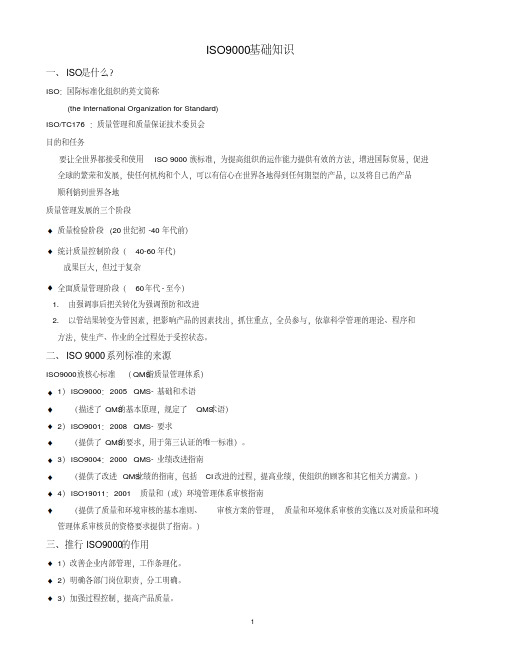
ISO9000基础知识一、ISO是什么?ISO:国际标准化组织的英文简称(the International Organization for Standard)ISO/TC176 :质量管理和质量保证技术委员会目的和任务要让全世界都接受和使用ISO 9000族标准,为提高组织的运作能力提供有效的方法,增进国际贸易,促进全球的繁荣和发展,使任何机构和个人,可以有信心在世界各地得到任何期望的产品,以及将自己的产品顺利销到世界各地质量管理发展的三个阶段质量检验阶段(20世纪初-40年代前)统计质量控制阶段(40-60年代)成果巨大,但过于复杂全面质量管理阶段(60年代-至今)1.由强调事后把关转化为强调预防和改进2.以管结果转变为管因素,把影响产品的因素找出,抓住重点,全员参与,依靠科学管理的理论、程序和方法,使生产、作业的全过程处于受控状态。
二、ISO 9000系列标准的来源ISO9000族核心标准(QMS指质量管理体系)1)ISO9000:2005 QMS-基础和术语(描述了QMS的基本原理,规定了QMS术语)2)ISO9001:2008 QMS-要求(提供了QMS的要求,用于第三认证的唯一标准)。
3)ISO9004:2000 QMS-业绩改进指南(提供了改进QMS业绩的指南,包括CI改进的过程,提高业绩,使组织的顾客和其它相关方满意。
)4)ISO19011:2001 质量和(或)环境管理体系审核指南(提供了质量和环境审核的基本准则、审核方案的管理,质量和环境体系审核的实施以及对质量和环境管理体系审核员的资格要求提供了指南。
)三、推行ISO9000的作用1)改善企业内部管理,工作条理化。
2)明确各部门岗位职责,分工明确。
3)加强过程控制,提高产品质量。
4)提高公司知名度并扩大市场占有率。
5)提高员工素质,使其自觉地为实现公司目标而努力。
四、ISO9001与ISO9004的关系1、联系:都是质量管理体系标准,它们互相补充,也可单独使用。
ISO9001-2015质量管理体系最新版标准(同名17598)
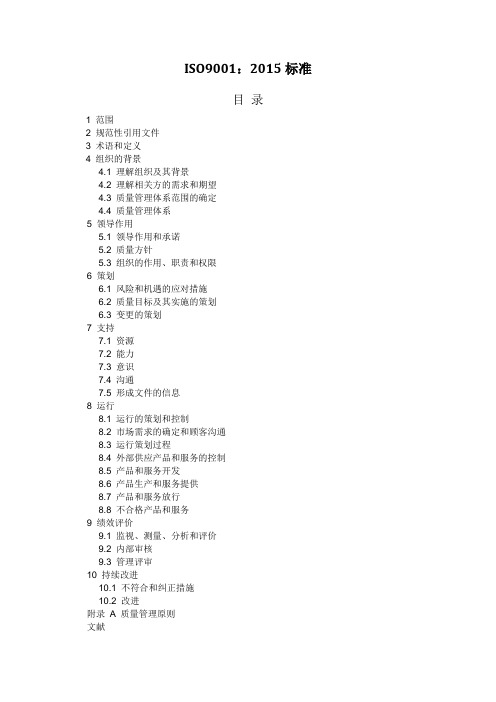
ISO9001:2015标准目录1 范围2 规范性引用文件3 术语和定义4 组织的背景4.1 理解组织及其背景4.2 理解相关方的需求和期望4.3 质量管理体系范围的确定4.4 质量管理体系5 领导作用5.1 领导作用和承诺5.2 质量方针5.3 组织的作用、职责和权限6 策划6.1 风险和机遇的应对措施6.2 质量目标及其实施的策划6.3 变更的策划7 支持7.1 资源7.2 能力7.3 意识7.4 沟通7.5 形成文件的信息8 运行8.1 运行的策划和控制8.2 市场需求的确定和顾客沟通8.3 运行策划过程8.4 外部供应产品和服务的控制8.5 产品和服务开发8.6 产品生产和服务提供8.7 产品和服务放行8.8 不合格产品和服务9 绩效评价9.1 监视、测量、分析和评价9.2 内部审核9.3 管理评审10 持续改进10.1 不符合和纠正措施10.2 改进附录 A 质量管理原则文献1 范围本标准为有下列需求的组织规定了质量管理体系要求:a)需要证实其具有稳定地提供满足顾客要求和适用法律法规要求的产品和服务的能力;b)通过体系的的有效应用,包括体系持续改进的过程,以及保证符合顾客和适用的法律法规要求,旨在增强顾客满意。
注1:在本标准一中,术语“产品”仅适用于:a) 预期提供给顾客或顾客所要求的商品和服务;b) 运行过程所产生的任何预期输出。
注2:法律法规要求可称作为法定要求。
2 规范性引用文件下列文件中的条款通过本标准的引用而构成本标准的条款。
凡是注日期的引用文件,只有引用的版本适用。
凡是不注日期的引用文件,其最新版本(包括任何修订)适用于本标准。
ISO9000:2015 质量管理体系基础和术语3 术语和定义本标准采用ISO9000:2015 中所确立的术语和定义。
4 组织的背景环境4.1 理解组织及其背景环境组织应确定外部和内部那些与组织的宗旨、战略方向有关、影响质量管理体系实现预期结果的能力的事务。
质量管理教程(第二版)课后题答案
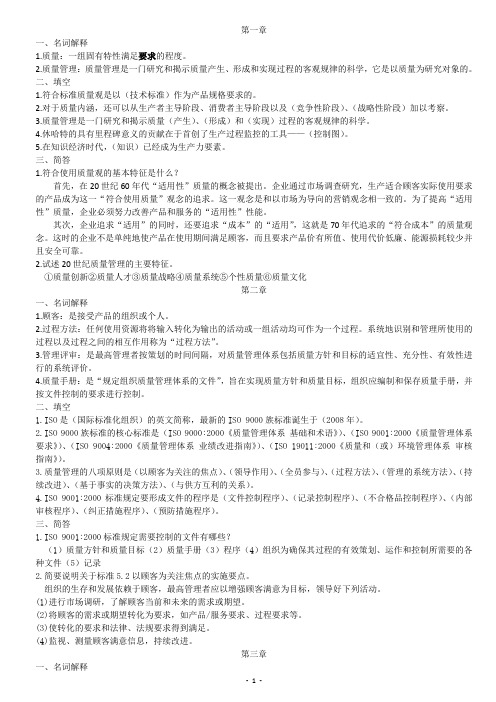
第一章一、名词解释1.质量:一组固有特性满足要求的程度。
2.质量管理:质量管理是一门研究和揭示质量产生、形成和实现过程的客观规律的科学,它是以质量为研究对象的。
二、填空1.符合标准质量观是以(技术标准)作为产品规格要求的。
2.对于质量内涵,还可以从生产者主导阶段、消费者主导阶段以及(竞争性阶段)、(战略性阶段)加以考察。
3.质量管理是一门研究和揭示质量(产生)、(形成)和(实现)过程的客观规律的科学。
4.休哈特的具有里程碑意义的贡献在于首创了生产过程监控的工具——(控制图)。
5.在知识经济时代,(知识)已经成为生产力要素。
三、简答1.符合使用质量观的基本特征是什么?首先,在20世纪60年代“适用性”质量的概念被提出。
企业通过市场调查研究,生产适合顾客实际使用要求的产品成为这一“符合使用质量”观念的追求。
这一观念是和以市场为导向的营销观念相一致的。
为了提高“适用性”质量,企业必须努力改善产品和服务的“适用性”性能。
其次,企业追求“适用”的同时,还要追求“成本”的“适用”,这就是70年代追求的“符合成本”的质量观念。
这时的企业不是单纯地使产品在使用期间满足顾客,而且要求产品价有所值、使用代价低廉、能源损耗较少并且安全可靠。
2.试述20世纪质量管理的主要特征。
①质量创新②质量人才③质量战略④质量系统⑤个性质量⑥质量文化第二章一、名词解释1.顾客:是接受产品的组织或个人。
2.过程方法:任何使用资源将将输入转化为输出的活动或一组活动均可作为一个过程。
系统地识别和管理所使用的过程以及过程之间的相互作用称为“过程方法”。
3.管理评审:是最高管理者按策划的时间间隔,对质量管理体系包括质量方针和目标的适宜性、充分性、有效性进行的系统评价。
4.质量手册:是“规定组织质量管理体系的文件”,旨在实现质量方针和质量目标,组织应编制和保存质量手册,并按文件控制的要求进行控制。
二、填空1.ISO是(国际标准化组织)的英文简称,最新的ISO 9000族标准诞生于(2008年)。
ISO9000:2000标准质量认证体系文件
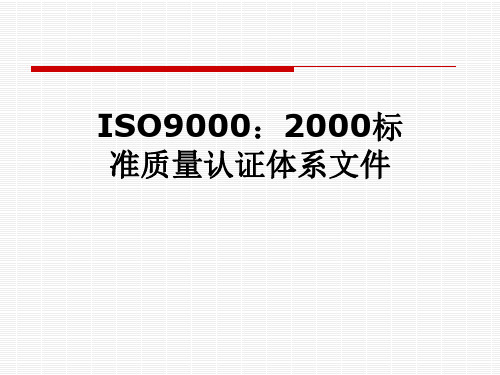
顾客 供方
服务 需要
市场 开发 过程
服务规范
服务提供 规范 质量控制 规范
供方 顾客
服务 提供 过程
服务 结束
服务业绩 分析和改进
供方评定
顾客评定
服务需要/结果
服务过程
服务过程文件
服务测量
服务质量环
2.5 质量管理标准的产生 A、 第一个标准:
美国Mil Spec Mil-Q9858(1959) B、 英国BS5750(1979年) C、 ISO9000--1987
(5)审核:GB/T19000:2000第3.6.1条 为获得审核证据并对其进行客观的评价,以确 定满足审核准则的程度所进行的系统的,独立 的并形成文件的过程。
(6)过程:GB/T19000:2000第3.4.1条 一组将输入转化为输出的相互关联或相互 作用的活动。
注:1、一个过程的输入通常是其他过程的输出。
B、只有坚持持续改进、组织才能不断进步; C、最高管理者应对持续改进作出承诺; D、全体员工应积极参与持续改进活动; E、持续改进是组织永恒的追求、目标和活动
7)原则七:基于事实的决策方法
理解要点:
A、决策是组织中各级领导职责之一; B、所谓决策即是针对目标,在一定的约束条件下, 从诸方案中选出一个付诸实施,达不到目标的决策 即为失策;
理解要点:
A、系统:相互关联或互相作用的一组要素; B、系统方法:包括系统分析、系统工程和系统管
理三大环节。
即:通过系统分析相关数据、资料或客规事实, 以确定目标;通过系统工程、设计、策划为达到 目标而采取措施、步骤、资源配置形式方案;通 过系统管理在实施中取得高有效率和高效率。
C、质量管理中采用系统方法,即把QMS作为大系
顾客需求管理程序文件

顾客需求管理程序
1.目的
为正确理解和了解顾客的要求与期望,确定满足顾客要求的产品质量,以确保公司按合同要求向顾客提供产品,使顾客满意。
2.围
本程序适用于销售合同、订单、标书、技术协议的评审。
3.引用文件
Q/6DG13.402-2003《质量记录控制程序》
Q/6DG13.703-2003《顾客特殊要求管理程序》
6.3.2总金额小于300万元的标书,采取部评审方式。评审结论由分厂厂长签字认可。
6.4非正规合同(定货等)的评审:
对于非正规合同,由合同签订单位持有法人委托证书的合同签订人员将顾客要求形成书面文件,并与时征得顾客对合同具体容的确认(如通过复述等方式),采用自行评审方式。
6.5外贸合同的评审:
外贸合同采取集中评审方式。评审结论由总经理签字认可。
“产品成本核算报价表”
6. 合同评审:
合同签订单位在接到顾客的合同后,由主管人员根据合同的类别,决定合同的评审方式。合同评审的容主要是合同所涉与的条款,包括:产品名称、规格、型号、交货数量、交货方式、交付日期、产品质量要求、技术要求、验收规、接收准则、
价格、付款方式、产品包装方式与要求、
工作流程
工作容说明
9.2.1顾客关于产品要求的信息(如:产品质量要求、技术要求、验收标准、接收准则等);
9.2.2询问合同或订单的处理,包括对其的修改;
9.2.3在产品实现过程中以与向顾客提供产品后顾客的反馈信息,包括顾客抱怨和投诉。
9.3当顾客有要求时,公司必须按顾客规定的语言和要求的方式来传递必要的信息和数据资料,同时使产品质量的相关信息和
说明资料在公司组织得到沟通和交流,以确保公司的产品质量、交付、服务符合和满足顾客的要求和需求。
ISO9001-2015质量管理体系-要求_中文
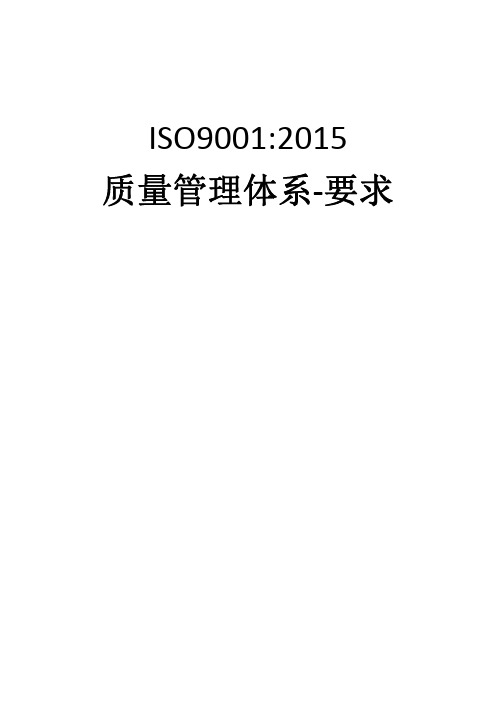
ISO9001:2015质量管理体系‐要求目录前言 (I)引言................................................................................... I I0.1 总则.................................................................................. I I0.2 质量管理原则.......................................................................... I I0.3 过程方法............................................................................. I II0.4 与其他管理体系标准的关系 (V)1. 范围 (1)2 规范性引用文件 (1)3 术语和定义 (1)4 组织环境 (1)4.1 理解组织及其环境 (1)4.2 理解相关方的需求和期望 (1)4.3 确定质量管理体系的范围 (1)4.4 质量管理体系及其过程 (2)5 领导作用 (2)5.1 领导作用和承诺 (2)5.1.1 总则 (2)5.1.2 以顾客为关注焦点 (2)5.2 方针 (3)5.2.1 制定质量方针 (3)5.2.2 沟通质量方针 (3)5.3 组织的岗位、职责和权限 (3)6 策划 (3)6.1 应对风险和机遇的措施 (3)6.2 质量目标及其实现的策划 (4)6.3 变更的策划 (4)7 支持 (4)7.1 资源 (4)7.2 能力 (6)7.3 意识 (6)7.4 沟通 (6)7.5 形成文件的信息 (6)8 运行 (7)8.1 运行策划和控制 (7)8.2 产品和服务的要求 (7)8.2.1 顾客沟通 (7)8.2.2 与产品和服务有关的要求的确定 (7)8.2.3 产品和服务有关的要求的评审 (8)8.2.4 产品和服务要求的更改 (8)8.3 产品和服务的设计和开发 (8)8.3.1 总则 (8)8.3.2 设计和开发策划 (8)8.3.3 设计和开发输入 (8)8.3.4 设计和开发控制 (9)8.3.5 设计和开发输出 (9)8.3.6 设计和开发更改 (9)8.4 外部提供过程、产品和服务的控制 (9)8.4.1总则 (9)8.4.2 控制类型和程度 (10)8.5 生产和服务提供 (10)8.6 产品和服务的放行 (11)8.7不合格输出的控制 (12)9 绩效评价 (12)9.1 监视、测量、分析和评价 (12)9.2 内部审核 (13)9.3 管理评审 (13)10 持续改进 (14)10.1总则 (14)10.2 不合格和纠正措施 (14)10.3 持续改进 (15)附录A(资料性附录) (16)附录B(资料性附录) (19)参考文献 (22)本标准按照GB/T 1.1—2009给出的规则起草。
4P营销理论概述
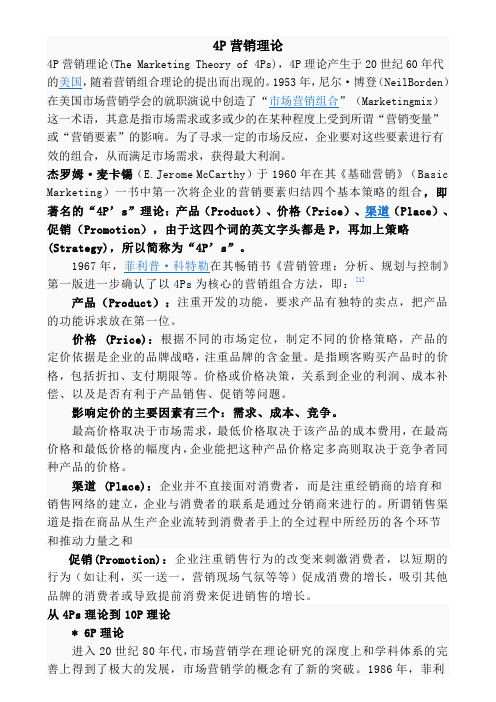
4P营销理论4P营销理论(The Marketing Theory of 4Ps),4P理论产生于20世纪60年代的美国,随着营销组合理论的提出而出现的。
1953年,尼尔·博登(NeilBorden)在美国市场营销学会的就职演说中创造了“市场营销组合”(Marketingmix)这一术语,其意是指市场需求或多或少的在某种程度上受到所谓“营销变量”或“营销要素”的影响。
为了寻求一定的市场反应,企业要对这些要素进行有效的组合,从而满足市场需求,获得最大利润。
杰罗姆·麦卡锡(E.Jerome McCarthy)于1960年在其《基础营销》(Basic Marketing)一书中第一次将企业的营销要素归结四个基本策略的组合,即著名的“4P’s”理论:产品(Product)、价格(Price)、渠道(Place)、促销(Promotion),由于这四个词的英文字头都是P,再加上策略(Strategy),所以简称为“4P’s”。
1967年,菲利普·科特勒在其畅销书《营销管理:分析、规划与控制》第一版进一步确认了以4Ps为核心的营销组合方法,即:[1]产品(Product):注重开发的功能,要求产品有独特的卖点,把产品的功能诉求放在第一位。
价格 (Price):根据不同的市场定位,制定不同的价格策略,产品的定价依据是企业的品牌战略,注重品牌的含金量。
是指顾客购买产品时的价格,包括折扣、支付期限等。
价格或价格决策,关系到企业的利润、成本补偿、以及是否有利于产品销售、促销等问题。
影响定价的主要因素有三个:需求、成本、竞争。
最高价格取决于市场需求,最低价格取决于该产品的成本费用,在最高价格和最低价格的幅度内,企业能把这种产品价格定多高则取决于竞争者同种产品的价格。
渠道 (Place):企业并不直接面对消费者,而是注重经销商的培育和销售网络的建立,企业与消费者的联系是通过分销商来进行的。
洲际酒店客房(中英文版)SOP
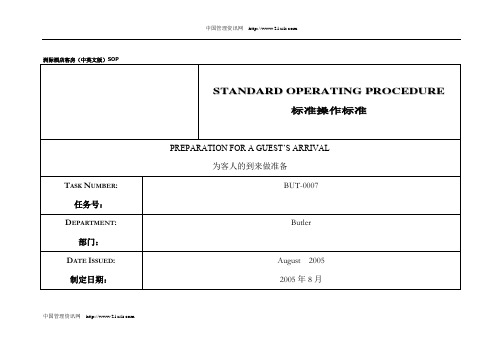
中国管理资讯网中国管理资讯网中国管理资讯网中国管理资讯网中国管理资讯网中国管理资讯网中国管理资讯网中国管理资讯网中国管理资讯网中国管理资讯网中国管理资讯网Summary questions:问题概述:1.Where should the Butler wait for the Guest?管家应该在哪里等客人?2.Which steps need to be followed when checking the guest in?在客人登记时,应做哪些步骤?3.Why is it important that we take the guest to the room?为什么带客人到房间非常重要?4.Should all guests receive an introduction to the room / hotel?所有客人都要求介绍房间和酒店吗?5.What do I have to introduce and why?我们必须介绍什么?为什么?Now ask the trainee to practice the task from start to end to test competency.现在由培训生按照步骤从头到尾进行实践操作并做测试中国管理资讯网中国管理资讯网中国管理资讯网中国管理资讯网中国管理资讯网3.W hy do I need to apologize?为什么我要道歉?4.W hat is important about taking action?采取行动时什么最重要?5.W hy is the follow up so important?为什么跟进如此重要?6.A re all complaints reported on the Log Book in your department?所有的投诉都需要记录进你部门的记录本吗?7.A re all complaints reported to the Executive office?所有的投诉都需要报告行政办公室吗?Now ask the trainee to practice the task from start to end to test competency.现在由培训生按照步骤从头到位进行实践操作并做测试。
(完整版)ISO9001:2015标准质量管理体系最新版标准
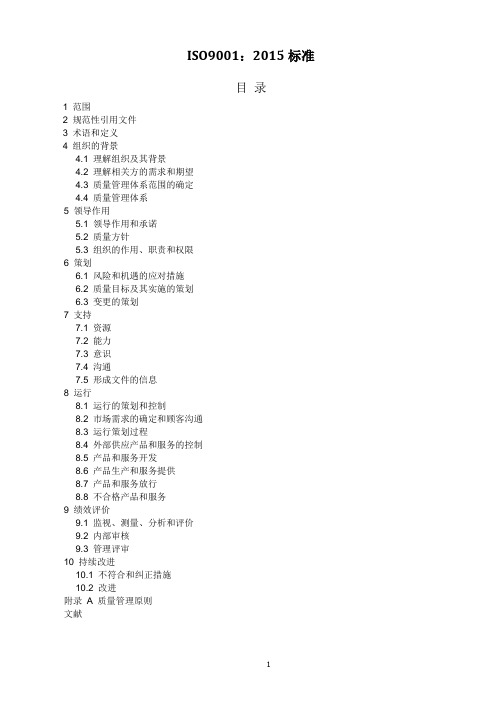
ISO9001:2015标准目录1 范围2 规范性引用文件3 术语和定义4 组织的背景4.1 理解组织及其背景4.2 理解相关方的需求和期望4.3 质量管理体系范围的确定4.4 质量管理体系5 领导作用5.1 领导作用和承诺5.2 质量方针5.3 组织的作用、职责和权限6 策划6.1 风险和机遇的应对措施6.2 质量目标及其实施的策划6.3 变更的策划7 支持7.1 资源7.2 能力7.3 意识7.4 沟通7.5 形成文件的信息8 运行8.1 运行的策划和控制8.2 市场需求的确定和顾客沟通8.3 运行策划过程8.4 外部供应产品和服务的控制8.5 产品和服务开发8.6 产品生产和服务提供8.7 产品和服务放行8.8 不合格产品和服务9 绩效评价9.1 监视、测量、分析和评价9.2 内部审核9.3 管理评审10 持续改进10.1 不符合和纠正措施10.2 改进附录A 质量管理原则文献1 范围本标准为有下列需求的组织规定了质量管理体系要求:a)需要证实其具有稳定地提供满足顾客要求和适用法律法规要求的产品和服务的能力;b)通过体系的的有效应用,包括体系持续改进的过程,以及保证符合顾客和适用的法律法规要求,旨在增强顾客满意。
注1:在本标准一中,术语“产品”仅适用于:a) 预期提供给顾客或顾客所要求的商品和服务;b) 运行过程所产生的任何预期输出。
注2:法律法规要求可称作为法定要求。
2 规范性引用文件下列文件中的条款通过本标准的引用而构成本标准的条款。
凡是注日期的引用文件,只有引用的版本适用。
凡是不注日期的引用文件,其最新版本(包括任何修订)适用于本标准。
ISO9000:2015 质量管理体系基础和术语3 术语和定义本标准采用ISO9000:2015 中所确立的术语和定义。
4 组织的背景环境4.1 理解组织及其背景环境组织应确定外部和内部那些与组织的宗旨、战略方向有关、影响质量管理体系实现预期结果的能力的事务。
最新iso9001-中文版(完整)
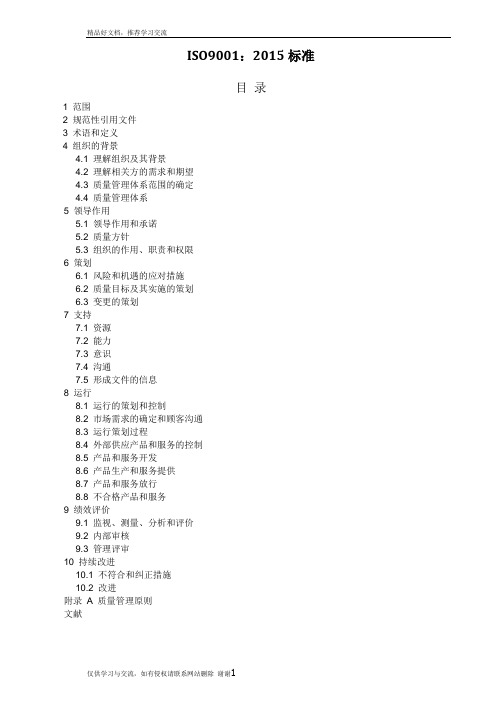
ISO9001:2015标准目录1 范围2 规范性引用文件3 术语和定义4 组织的背景4.1 理解组织及其背景4.2 理解相关方的需求和期望4.3 质量管理体系范围的确定4.4 质量管理体系5 领导作用5.1 领导作用和承诺5.2 质量方针5.3 组织的作用、职责和权限6 策划6.1 风险和机遇的应对措施6.2 质量目标及其实施的策划6.3 变更的策划7 支持7.1 资源7.2 能力7.3 意识7.4 沟通7.5 形成文件的信息8 运行8.1 运行的策划和控制8.2 市场需求的确定和顾客沟通8.3 运行策划过程8.4 外部供应产品和服务的控制8.5 产品和服务开发8.6 产品生产和服务提供8.7 产品和服务放行8.8 不合格产品和服务9 绩效评价9.1 监视、测量、分析和评价9.2 内部审核9.3 管理评审10 持续改进10.1 不符合和纠正措施10.2 改进附录A 质量管理原则文献1 范围本标准为有下列需求的组织规定了质量管理体系要求:a)需要证实其具有稳定地提供满足顾客要求和适用法律法规要求的产品和服务的能力;b)通过体系的的有效应用,包括体系持续改进的过程,以及保证符合顾客和适用的法律法规要求,旨在增强顾客满意。
注1:在本标准一中,术语“产品”仅适用于:a) 预期提供给顾客或顾客所要求的商品和服务;b) 运行过程所产生的任何预期输出。
注2:法律法规要求可称作为法定要求。
2 规范性引用文件下列文件中的条款通过本标准的引用而构成本标准的条款。
凡是注日期的引用文件,只有引用的版本适用。
凡是不注日期的引用文件,其最新版本(包括任何修订)适用于本标准。
ISO9000:2015 质量管理体系基础和术语3 术语和定义本标准采用ISO9000:2015 中所确立的术语和定义。
4 组织的背景环境4.1 理解组织及其背景环境组织应确定外部和内部那些与组织的宗旨、战略方向有关、影响质量管理体系实现预期结果的能力的事务。
教你如何理解顾客的需求和期望(英文)(pdf 34页)
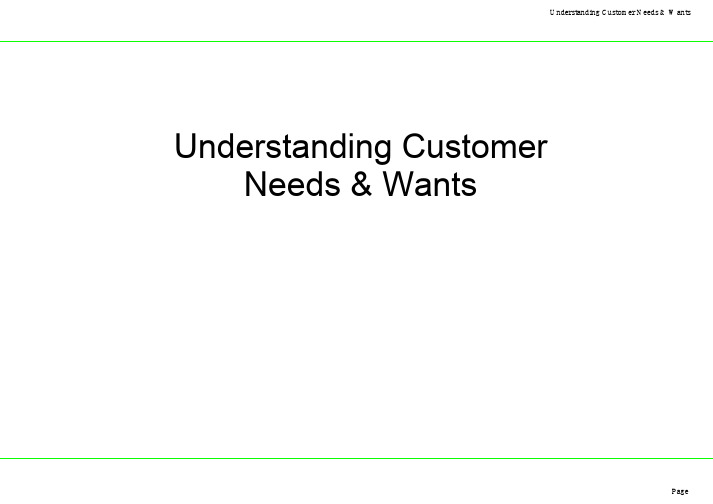
Understanding Customer Needs & WantsSession PurposeTo reinforce the customer-focused mindset and practice the skills of uncovering the customer's needs & wants.Learning ObjectivesTake a customer-focused approach to sellingKeep abreast of developments in the account and/ormarketplace that may impact the businessIdentify the clients within a customer organizationWrite a discussion paper to confirm opportunityAt the end of this session you will be able to:Our RoleFirst StepsTo help the customer achieve the desired results, we must first understand his needs and wants.Understand Customer Needs and Wants: The ProcessExercise: How Can You Help?Imagine yourself in the scene that isdescribed to you.You can ask closed questions and findout more about the situation,to decide howyou can help him.Instructions:Go into the engagement with an open mindHave the best interests of the customer at heartDo not assume that you know what is best for the customerPractice good questioning and listening skillsListen for content as well as feelings and evaluate whatyou hear from the customer's point of viewConstantly check with the customer for understandingThe Word Association Game Instructions:1. We are dividing the class into 2 groups: Apples and Oranges2. Apples: Imagine you are the customer3. Oranges: You are the M M client/sales specialist just gone on quota4. I am going say a list of words. As you hear the word, just shout the firstwords that come to mindBridging The DifferenceYour customer has different sets of experiences and perceptionsThey have specific needs&wants depending on their operatingenvironment and their personalitiesThey are in the best position to communicate these to youInvolve them as much as possible in the sales process to deepen yourunderstanding and to gain their buy-in to the eventual solutionBenefits of the Customer-Focused Approach Your customer will appreciate your sincerity and professional integritywhich sets a good basis for a long term relationshipDeep understanding of your clients and their organization, equips youwith the knowledge to put together a differentiated solution that is trulyresponsive to the customer's needs & wantsYou will gain industry knowledge and business acumen through theseexperiences and enhances your competencies and career growthCustomer Participation In the Sales ProcessThe Sales ProcessP a r t i c i p a t i o nWhat It TakesCustomer Needs &WantsPersonal Leadership CompetenceMM and IT Specific CompetenceAccount &IndustryCompetenceLeadership ValuesInterpersonalCommunication Problem-SolvingMM Offerings MM Processes IT Architectures IT Industry TrendsIndustry Trends & Current Issues Major PlayersIndustry ApplicationsRelative Importance Of Competencies During the Sales ProcessThe Sales ProcessR e l a t i v e I m p o r t a n ceIdentify Your ClientsA key step in understanding your customer's needs&wants is knowing who your clients are. A client:Must be a person, not a position or entityIs the person(s) who provides direct input on solution needsYou may have multiple clients within an organization. The most important is to identify your primary client who:Owns the problems and needs helphas the authority to make decisionsWe work with clients within the customer organizationClients with Differing InterestsDifferent clients at different levels of the organization have different priorities and interests.Think of two interests the clients at each levelMaking the Call Appointment Identify who you are going to call on in the organization to understand their needs and wantsBe pleasant and purposeful in setting the appoint ment, state clearly, the purpose of the callPlan Your CallKeeps your calls focusedMakes effective use of time: yours and the client's Communicates professionalismPlan FactorsThe call objectiveWho you are calling onClient's role in the buying processWhat information do you need to find outYour client's potential expectations and concernsWhat do you need to bring with you to make your clients comfortableWhy Do ItWhat Do You Need To Find Out?Current business environmentMajor initiatives in the organizationKey challengesClient's hopes and fearsCurrent systems used and performanceSome Suggested AreasKey players and process in IT investment decisionsCompany backgroundAlternative Sources of Account & Marketplace InformationTap knowledge of colleaguesReview existing account plans and update as requiredRead widely and regularlyConduct research, segment studies to deepen knowledgeExpand coverage of account/territory for fresh news Keep a lookout for new developments in ITStay Abreast of DevelopmentsStay alert for competitive activityExercise: Questioning to Specific Interests List the questions you can ask clients to determine their needs andwants in the following areas:Their business goals and objectivesThe business need and challengesChoosing the solution providerThe technical requirementsThe approval process and key playersRemember to focus on both the content and the feelings!Call Planning Exercise Instructions1.You are going to call on a client2.Read the brief on the client and the companying the call-planning worksheet, and prepare for the call4.The purpose of your call is to uncover the client's needs andwantsRemember to practice your questioning & listening skills!Call Planning WorksheetCompany Areasof Interest DateClient Name DesignationInformation I am interested in: Call objectivesDecision-Maker Key Recommender InfluencerBusiness TechnicalInformation client may ask forFollow-up actionsWhat Next?You have got a lot of information from the clientOrganize the information in a discussion paperUse the discussion paper to check for understanding and to set client's expectationsDevelop A Discussion PaperA discussion paper documents our understanding of the customer's needs and wants and presents our thoughts and suggested approach to help the client organization achieve their goalsThe discussion paper serves to gain agreement between the client and M M on:the customer's business environmentthe aspirations & challengesthe desired outcome of the business relationshipContents Of A Discussion Paper A typical discussion paper would include:IntroductionProblems/Issues/Opportunity StatementThe DiscussionConclusionContents Of A Discussion Paper IntroductionEvents leading to the discussion paperPeople who contributed to the discussion paperProblem/Issue/Opportunity StatementDescribes the business problem,issues,and the opportunityContents of A Discussion Paper An overview of our thinking, ideas, suggestions, or optionson how we can approach the problem/issue/opportunityThe assumptions we have madeAreas where we need more informationOur/MM experience in similar situationsInvitation for client to give feedback and commentsOutline of the next step, or alternatives, for proceedingNote of thanks to client for opportunityThe DiscussionConclusionDiscussion Paper vs A ProposalContent:Responsibility forsuggestions:Legal status:Next step:Response requiredfrom client:Assumption:Discussion PaperBetween us we "know"Comment/Feedback Open/tentative Joint Almost never include product.Usually contains problemanalysis, ideas, options, etc.Proposal I "knows"Yes or No Order/Contract Formal document I Includes HW,prices, etc.ProposalSuggested FormatThe following writing format is recommended to facilitate effective discussionsHorizontal Logic : logic that connects a headline to the one thatprecedes it and to the one that follows itVertical Logic :the logic thatstructures anindividual pageHeadlines in Discussion PaperThe headlineHeadline: A full sentence that makes an assertionSupport: details to logically support the assertion in the headlineHeadlines in Discussion Paper The client can understand your message by reading the headlines.Exercise: Writing A Discussion PaperYou have called on your clientReview all the information that you have uncovered so farGet into your assigned groupsAs a team,develop a discussion paper, to capture your understandingof the customer's needs and wantsPresent the discussion paper to the classInstructionsCustomer Agreement to Discussion Paper The discussion paper serves as the basis for us to develop and designa solution to meet the customer needs & wants。
ISO9000讲解教材
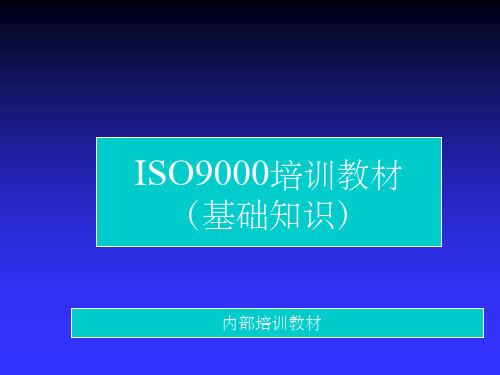
(一)以顾客为关注焦点
识别顾客的需求与期望 确保组织的目标与顾客的需求相一致 确保在组织内部沟通顾客的需求与期望 测量顾客的满意程度并根据结果采取相关的活动或措
求,严格按文件要求实施;
2、 以质量管理体系八项原则指导实际工作,响应公 司的质量体系活动;
3、理解公司质量方针和质量目标,明确质量目标与本 岗位工作的相关性,为部门质量目标的实现作出贡献。
一次专业知识培训,并进行资格认可。 3、 产品质量达到国家标准力争部分超过国家标准。 4、 所有零配件终身免费更换(国家规定报废年限内)。 5、 整机返修率和用户投诉率≤5%。 6、 全力贯彻ISO9001:2000质量管理体系,提高质量
管理水平。
7、24小时内响应服务。
九、参与公司的质量管理体系的基本要求 1、学习公司质量体系文件,了解公司的质量体系要
董事会 总经理
副 总 经 理 /生 产 总 监 生产中心
管理者代表 营销总监 营销中心
研 发
研 发
工
品
计
商 用 空
技 术 中
二三 艺质测调 心
部部
制认
部
部
部
造 厂
证 办
生 生 生 生生 物 生 设物 产 产 产 产产 料 产 备料 一 二 三 四工 配 管 管管 厂 厂 厂 厂艺 送 理 理理
科科科 科科
产
进 出
国 内
客
品 口各户
计 营营服
划 部
销 公 司
销 公 司
务 部
公成法供人行
品
力
ISO9001-2015标准
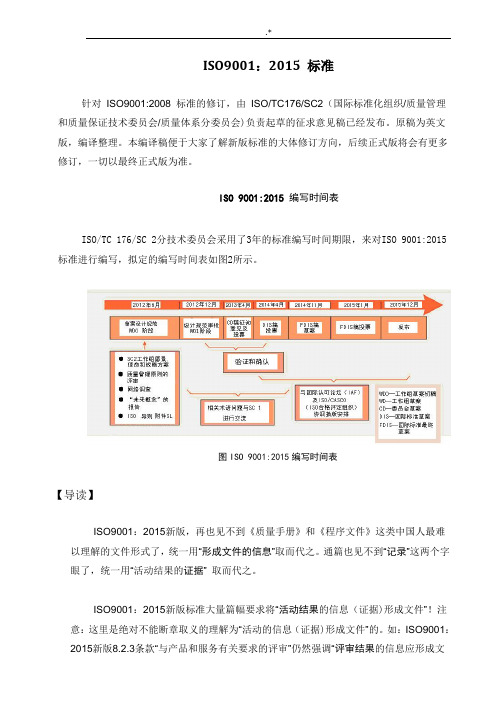
ISO9001:2015 标准针对ISO9001:2008 标准的修订,由ISO/TC176/SC2(国际标准化组织/质量管理和质量保证技术委员会/质量体系分委员会)负责起草的征求意见稿已经发布。
原稿为英文版,编译整理。
本编译稿便于大家了解新版标准的大体修订方向,后续正式版将会有更多修订,一切以最终正式版为准。
ISO 9001:2015 编写时间表ISO/TC 176/SC 2分技术委员会采用了3年的标准编写时间期限,来对ISO 9001:2015标准进行编写,拟定的编写时间表如图2所示。
图ISO 9001:2015编写时间表【导读】ISO9001:2015新版,再也见不到《质量手册》和《程序文件》这类中国人最难以理解的文件形式了,统一用“形成文件的信息”取而代之。
通篇也见不到“记录”这两个字眼了,统一用“活动结果的证据”取而代之。
ISO9001:2015新版标准大量篇幅要求将“活动结果的信息(证据)形成文件”!注意:这里是绝对不能断章取义的理解为“活动的信息(证据)形成文件”的。
如:ISO9001:2015新版8.2.3条款“与产品和服务有关要求的评审”仍然强调“评审结果的信息应形成文件”、ISO9001:2015新版8.4.2条款“外部供方的控制类型和程序”仍然强调“评价结果的信息应形成文件”、ISO9001:2015新版9.3条款“管理评审”仍然强调“管理评审结果的证据”、ISO9001:2015新版9.1.3条款“数据分析和评价”仍然强调“数据分析和评价结果”……还要特别强调的是,同老版本一样,ISO9001:2015新版标准几乎每个条款用的都是“动词”,如评审、验证、确认……等;也就是说:ISO9001:2015新版关注的仍然是:你是否有“动作”(即:实干兴邦)。
通篇见不到“记录”这两个字眼就是明证!因此,关注“动作”的存在和有效性,新版本比老版本有进一步的强化!ISO9001:2015标准目录1 范围2 规范性引用文件3 术语和定义4 组织的背景4.1 理解组织及其背景4.2 理解相关方的需求和期望4.3 质量管理体系范围的确定4.4 质量管理体系5 领导作用5.1 领导作用和承诺5.2 质量方针5.3 组织的作用、职责和权限6 策划6.1 风险和机遇的应对措施6.2 质量目标及其实施的策划6.3 变更的策划7 支持7.1 资源7.2 能力7.3 意识7.4 沟通7.5 形成文件的信息8 运行8.1 运行的策划和控制8.2 市场需求的确定和顾客沟通8.3 运行策划过程8.4 外部供应产品和服务的控制8.5 产品和服务开发8.6 产品生产和服务提供8.7 产品和服务放行8.8 不合格产品和服务9 绩效评价9.1 监视、测量、分析和评价9.2 内部审核9.3 管理评审10 持续改进10.1 不符合和纠正措施10.2 改进附录A 质量管理原则文献ISO9001:2015标准前言(略)委员会征求意见稿说明(略)质量管理体系-要求1 范围本标准为有下列需求的组织规定了质量管理体系要求:a)需要证实其具有稳定地提供满足顾客要求和适用法律法规要求的产品和服务的能力;b)通过体系的的有效应用,包括体系持续改进的过程,以及保证符合顾客和适用的法律法规要求,旨在增强顾客满意。
GB-T19000 质量管理体系 基础和术语
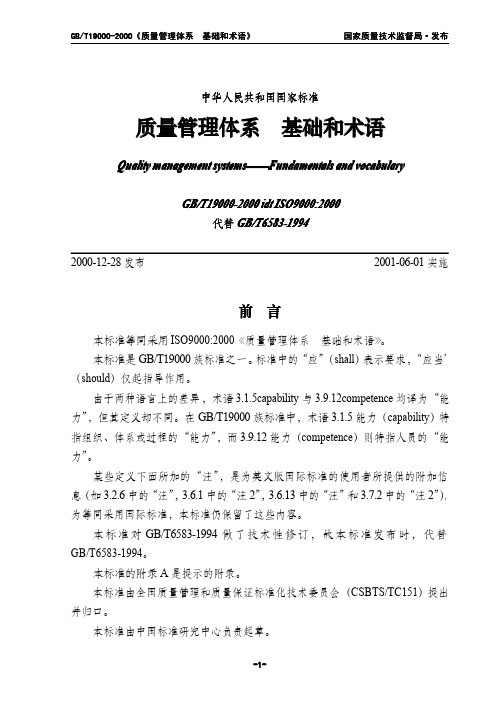
中华人民共和国国家标准质量管理体系基础和术语Quality management systems systems——————FundamentalsFundamentals and vocabulary GB/T19000-2000idt ISO9000:2000代替GB/T6583-19942000-12-28发布2001-06-01实施前言本标准等同采用ISO9000:2000《质量管理体系基础和术语》。
本标准是GB/T19000族标准之一。
标准中的“应”(shall )表示要求,“应当”(should )仅起指导作用。
由于两种语言上的差异,术语3.1.5capability 与3.9.12competence 均译为“能力”,但其定义却不同。
在GB/T19000族标准中,术语3.1.5能力(capability )特指组织、体系或过程的“能力”,而3.9.12能力(competence )则特指人员的“能力”。
某些定义下面所加的“注”,是为英文版国际标准的使用者所提供的附加信息(如3.2.6中的“注”,3.6.1中的“注2”,3.6.13中的“注”和3.7.2中的“注2”),为等同采用国际标准,本标准仍保留了这些内容。
本标准对GB/T6583-1994做了技术性修订,故本标准发布时,代替GB/T6583-1994。
本标准的附录A 是提示的附录。
本标准由全国质量管理和质量保证标准化技术委员会(CSBTS/TC151)提出并归口。
本标准由中国标准研究中心负责起草。
本标准起草单位:中国标准研究中心、中国合格评定国家认可中心、上海市标准化研究院、航天科技集团七○八研究所、中国船级社、深圳市中兴通讯股份有限公司、中国天辰化学工程公司、中国新时代质量体系认证中心。
本标准主要起草人:李镜、徐有刚、陆关新、郭瑞霞、顾作甫、李溯、乔悦生、郑燕。
ISO前言国际标准化组织(ISO)是由各国标准化团体(ISO成员团体)组成的世界性的联合会。
行销人员对顾客应有的认识
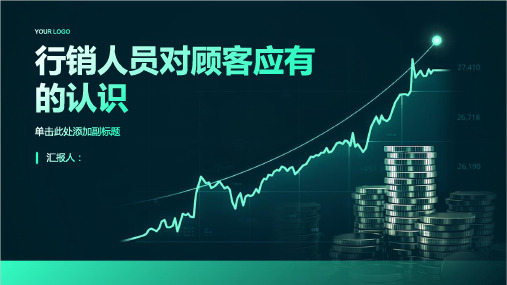
了解顾客心理
提高自身素质和 能力
建立良好的客户 关系
了解市场趋势和 竞争对手
深入了解顾客需求
顾客需求:了解顾客对产品或服务的需求,包括功能、价格、质量等方面 顾客行为:了解顾客的购买行为,包括购买频率、购买渠道、购买习惯等 顾客反馈:了解顾客对产品或服务的反馈,包括满意度、意见和建议等 顾客群体:了解顾客群体的特点,包括年龄、性别、职业、收入等
跟进问题解决: 跟进顾客问题的 解决情况,确保 问题得到解决
建立信任关系: 通过及时解决顾 客问题,建立良 好的信任关系
建立信任关系
诚实守信:言行一致,遵守承诺
尊重客户:尊重客户的需求和意见
专业能力:具备专业知识和技能,为客户 提供有价值的服务
持续沟通:保持与客户的沟通,了解客户 需求和变化
解决问题:积极解决客户问题,提供解决 方案
建立信任:通过以上方式,逐步建立与客 户的信任关系
分析顾客心理需求
顾客期望:了解顾客对产品 或服务的期望,包括品牌、 服务、售后等方面
顾客需求:了解顾客对产品 或服务的需求,包括功能、 价格、质量等方面
顾客满意度:了解顾客对产 品或服务的满意度,包括使
用体验、售后服务等方面
顾客忠诚度:了解顾客对产 品或服务的忠诚度,包括重 复购买、推荐给他人等方面
挖掘潜在需求
观察顾客行为:了解顾客的购买习惯和偏好 倾听顾客声音:听取顾客的意见和建议 分析顾客数据:通过数据分析了解顾客的需求和偏好 提供个性化服务:根据顾客的需求和偏好提供个性化的产品和服务
关注顾客反馈
顾客反馈的重要性:了解顾客需求,改进产品和服务 顾客反馈的收集方式:问卷调查、电话回访、社交媒体等 顾客反馈的分析:了解顾客的需求、期望和满意度 顾客反馈的运用:改进产品和服务,提高顾客满意度和忠诚度
IRIS铁路行业认证ISO22163-2017过程检查表(中文版)
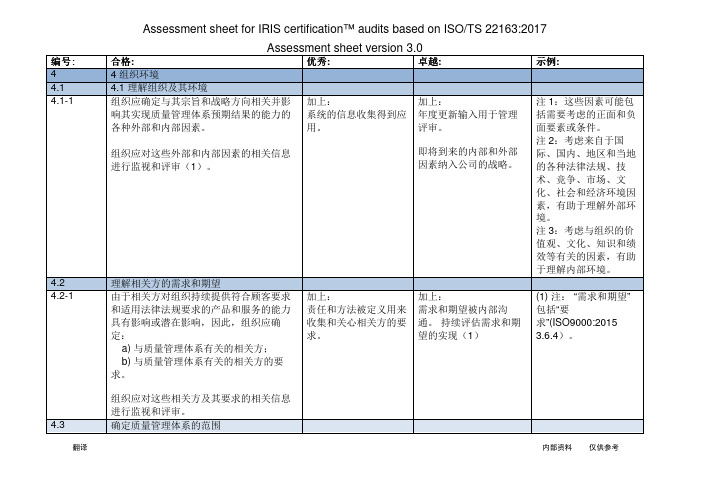
编号编号::合格:优秀: 卓越:示例: 4 4 组织环境4.1 4.1 理解组织及其环境4.1-1 组织应确定与其宗旨和战略方向相关并影响其实现质量管理体系预期结果的能力的各种外部和内部因素。
组织应对这些外部和内部因素的相关信息进行监视和评审(1)。
加上:系统的信息收集得到应用。
加上:年度更新输入用于管理评审。
即将到来的内部和外部因素纳入公司的战略。
注1:这些因素可能包括需要考虑的正面和负面要素或条件。
注2:考虑来自于国际、国内、地区和当地的各种法律法规、技术、竞争、市场、文化、社会和经济环境因素,有助于理解外部环境。
注3:考虑与组织的价值观、文化、知识和绩效等有关的因素,有助于理解内部环境。
4.2 理解相关方的需求和期望4.2-1 由于相关方对组织持续提供符合顾客要求和适用法律法规要求的产品和服务的能力具有影响或潜在影响,因此,组织应确定:a)与质量管理体系有关的相关方;b)与质量管理体系有关的相关方的要求。
组织应对这些相关方及其要求的相关信息进行监视和评审。
加上:责任和方法被定义用来收集和关心相关方的要求。
加上:需求和期望被内部沟通。
持续评估需求和期望的实现(1)(1) 注: “需求和期望”包括“要求”(ISO9000:20153.6.4)。
4.3 确定质量管理体系的范围翻译内部资料仅供参考编号编号::合格:优秀: 卓越:示例: 4.3-1 组织应明确质量管理体系的边界和适用性,以确定其范围。
在确定范围时,组织应考虑:a) 4.1 中提及的各种外部和内部因素b) 4.2 中提及的相关方的要求c)组织的产品和服务。
4.3-2 如果本标准的全部要求适用于组织确定的质量管理体系范围,组织应实施本标准的全部要求。
4.3-3 组织的质量管理体系范围应作为成文信息,可获得并得到保持。
该范围应描述所覆盖的产品和服务类型,如果组织确定本标准的某些要求不适用于其质量管理体系范围,应说明理由。
只有所确定的不适用的要求不影响组织确保其产品和服务合格的能力或责任,对增强顾客满意也不会产生影响,方可声称符合本标准的要求。
- 1、下载文档前请自行甄别文档内容的完整性,平台不提供额外的编辑、内容补充、找答案等附加服务。
- 2、"仅部分预览"的文档,不可在线预览部分如存在完整性等问题,可反馈申请退款(可完整预览的文档不适用该条件!)。
- 3、如文档侵犯您的权益,请联系客服反馈,我们会尽快为您处理(人工客服工作时间:9:00-18:30)。
Understanding Customer Needs & WantsSession PurposeTo reinforce the customer-focused mindset and practice the skills of uncovering the customer's needs & wants.Learning ObjectivesTake a customer-focused approach to sellingKeep abreast of developments in the account and/ormarketplace that may impact the businessIdentify the clients within a customer organizationWrite a discussion paper to confirm opportunityAt the end of this session you will be able to:Our RoleFirst StepsTo help the customer achieve the desired results, we must first understand his needs and wants.Understand Customer Needs and Wants: The ProcessExercise: How Can You Help? Instructions:Imagine yourself in the scene that isdescribed to you.You can ask closed questions and findout more about the situation,to decide howyou can help him.Go into the engagement with an open mindHave the best interests of the customer at heartDo not assume that you know what is best for the customerPractice good questioning and listening skillsListen for content as well as feelings and evaluate whatyou hear from the customer's point of viewConstantly check with the customer for understandingThe Word Association Game Instructions:1. We are dividing the class into 2 groups: Apples and Oranges2. Apples: Imagine you are the customer3. Oranges: You are the M M client/sales specialist just gone on quota4. I am going say a list of words. As you hear the word, just shout the firstwords that come to mindBridging The DifferenceYour customer has different sets of experiences and perceptionsThey have specific needs&wants depending on their operatingenvironment and their personalitiesThey are in the best position to communicate these to youInvolve them as much as possible in the sales process to deepen yourunderstanding and to gain their buy-in to the eventual solutionBenefits of the Customer-Focused Approach Your customer will appreciate your sincerity and professional integritywhich sets a good basis for a long term relationshipDeep understanding of your clients and their organization, equips youwith the knowledge to put together a differentiated solution that is trulyresponsive to the customer's needs & wantsYou will gain industry knowledge and business acumen through theseexperiences and enhances your competencies and career growthCustomer Participation In the Sales ProcessThe Sales ProcessP a r t i c i p a t i o nWhat It TakesCustomer Needs &WantsPersonal Leadership CompetenceM M and IT Specific CompetenceAccount & IndustryCompetenceLeadership ValuesInterpersonal Communication Problem-SolvingMM Offerings M M Processes IT Architectures IT Industry TrendsIndustry Trends & Current Issues Major PlayersIndustry ApplicationsRelative Importance Of Competencies During the Sales ProcessThe Sales ProcessR e l a t i v e I m p o r t a n ceIdentify Your ClientsA key step in understanding your customer's needs&wants is knowing who your clients are. A client:Must be a person, not a position or entityIs the person(s) who provides direct input on solution needsYou may have multiple clients within an organization. The most important is to identify your primary client who:Owns the problems and needs helphas the authority to make decisionsWe work with clients within the customer organizationClients with Differing InterestsDifferent clients at different levels of the organization have different priorities and interests.Think of two interests the clients at each levelMaking the Call Appointment Identify who you are going to call on in the organization to understand their needs and wantsBe pleasant and purposeful in setting the appoint ment, state clearly, the purpose of the callPlan Your CallWhy Do ItKeeps your calls focusedMakes effective use of time: yours and the client'sCommunicates professionalismPlan FactorsThe call objectiveWho you are calling onClient's role in the buying processWhat information do you need to find outYour client's potential expectations and concernsWhat do you need to bring with you to make your clients comfortableWhat Do You Need To Find Out?Current business environmentMajor initiatives in the organizationKey challengesClient's hopes and fearsCurrent systems used and performanceSome Suggested AreasKey players and process in IT investment decisionsCompany backgroundAlternative Sources of Account & Marketplace InformationTap knowledge of colleaguesReview existing account plans and update as requiredRead widely and regularlyConduct research, segment studies to deepen knowledgeExpand coverage of account/territory for fresh news Keep a lookout for new developments in ITStay Abreast of DevelopmentsStay alert for competitive activityExercise: Questioning to Specific Interests List the questions you can ask clients to determine their needs andwants in the following areas:Their business goals and objectivesThe business need and challengesChoosing the solution providerThe technical requirementsThe approval process and key playersRemember to focus on both the content and the feelings!Call Planning Exercise Instructions1.You are going to call on a client2.Read the brief on the client and the companying the call-planning worksheet, and prepare for the call4.The purpose of your call is to uncover the client's needs andwantsRemember to practice your questioning & listening skills!Call Planning WorksheetCompany Areasof Interest DateClient Name DesignationInformation I am interested in: Call objectivesDecision-Maker Key Recommender InfluencerBusiness TechnicalInformation client may ask forFollow-up actionsWhat Next?You have got a lot of information from the client Organize the information in a discussion paperUse the discussion paper to check for understanding and to set client's expectationsDevelop A Discussion PaperA discussion paper documents our understanding of the customer's needs and wants and presents our thoughts and suggested approach to help the client organization achieve their goalsThe discussion paper serves to gain agreement between the client and M M on:the customer's business environmentthe aspirations & challengesthe desired outcome of the business relationshipContents Of A Discussion Paper A typical discussion paper would include:IntroductionProblems/Issues/Opportunity StatementThe DiscussionConclusionContents Of A Discussion Paper IntroductionEvents leading to the discussion paperPeople who contributed to the discussion paperProblem/Issue/Opportunity StatementDescribes the business problem,issues,and the opportunityContents of A Discussion Paper An overview of our thinking, ideas, suggestions, or optionson how we can approach the problem/issue/opportunityThe assumptions we have madeAreas where we need more informationOur/MM experience in similar situationsInvitation for client to give feedback and commentsOutline of the next step, or alternatives, for proceedingNote of thanks to client for opportunityThe DiscussionConclusionDiscussion Paper vs A ProposalContent:Responsibility forsuggestions:Legal status:Next step:Response requiredfrom client:Assumption:Discussion PaperBetween us we "know"Comment/Feedback Open/tentative Joint Almost never include product.Usually contains problemanalysis, ideas, options, etc.Proposal I "knows"Yes or No Order/Contract Formal document I Includes HW,prices, etc.ProposalSuggested FormatThe following writing format is recommended to facilitate effective discussionsHorizontal Logic : logic that connects a headline to the one thatprecedes it and to the one that follows itVertical Logic :the logic thatstructures anindividual pageHeadlines in Discussion PaperThe headlineHeadline: A full sentence that makes an assertionSupport: details to logically support the assertion in the headlineHeadlines in Discussion Paper The client can understand your message by reading the headlines.Exercise: Writing A Discussion PaperYou have called on your clientReview all the information that you have uncovered so farGet into your assigned groupsAs a team,develop a discussion paper, to capture your understandingof the customer's needs and wantsPresent the discussion paper to the classInstructionsCustomer Agreement to Discussion Paper The discussion paper serves as the basis for us to develop and designa solution to meet the customer needs & wants。
